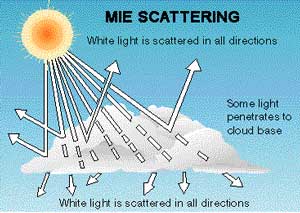THE NATURAL ENVIRONMENT
Geography 101
ToC
SKY
Origin
Air
Layers
Sunlight
Scatter
Refract
Hawai'i
Scattering
|
When sunlight reaches the Earth, it filters through the atmosphere before hitting the surface. On its path through the air, it reacts in various ways. One of the most colorful to sky watchers is scattering, which simply means changing direction. Scattering produces the familiar blues and whites that dominate the sky. |
Rayleigh Scattering
|
|
BOX 1 |
There are two distinct modes of scattering for sunlight. When the solar beam encounters tiny particles, like molecules, the shortest wavelengths are scattered much more strongly than longer wavelengths in a process called Rayleigh scattering. To be more precise: scattering is proportional to the fourth power of the inverse of the wavelength. Thus, UV scatters more than blue light, blue light scatters more than green light, green light scatters more than red light, and so on. Because of this wavelength-selective scattering, more blue light diffuses throughout atmosphere than other colors producing the familiar blue sky. Earth's atmosphere also appears blue from space for the same reason.
 Rayleigh
scattering also produces red sunsets. When the sun is
low on the horizon, the solar beam travels a slanted, longer
path through the
atmosphere. By the time the beam reaches your eye, the intensity of blue and
green light is greatly diminished by scattering, leaving a dominant red color. The most
colorful sunsets occur when this red light reflects off something
in the sky, like clouds or volcanic dust
Rayleigh
scattering also produces red sunsets. When the sun is
low on the horizon, the solar beam travels a slanted, longer
path through the
atmosphere. By the time the beam reaches your eye, the intensity of blue and
green light is greatly diminished by scattering, leaving a dominant red color. The most
colorful sunsets occur when this red light reflects off something
in the sky, like clouds or volcanic dust
Mie Scattering
 When
the solar beam encounters larger particles in the air, like cloud droplets
or dust, all wavelengths are scattered equally. This kind of
non-wavelength selective process, called Mie scattering,
produces white-colored light, making clouds appear white, for
example. So, if you look into the sky and see a deep blue color, you
know it is
relatively
free
of dust, pollen, and other particles that cause Mie scattering.
If it looks white and hazy, however,
you
know
the air
is filled with particles large enough to cause Mie scattering, such as
vog (smoke and other particles from Kilauea volcano).
When
the solar beam encounters larger particles in the air, like cloud droplets
or dust, all wavelengths are scattered equally. This kind of
non-wavelength selective process, called Mie scattering,
produces white-colored light, making clouds appear white, for
example. So, if you look into the sky and see a deep blue color, you
know it is
relatively
free
of dust, pollen, and other particles that cause Mie scattering.
If it looks white and hazy, however,
you
know
the air
is filled with particles large enough to cause Mie scattering, such as
vog (smoke and other particles from Kilauea volcano).
Mie scattering also produces crepuscular rays, such as those shown at sunset over Ni'ihau below. When the sun is low on the horizon, or below it, cloud shadows may vividly highlight beams penetrating to the surface. In a sense, the shadows reveal Mie scattering in the sunlit atmosphere by framing the solar beams with darkness. If you remove the shadow, the entire sky would be the color of the crepuscular rays and they would blend in and disappear.
Scattering through both modes causes some sunlight to approach Earth, and your eye, from a direction other than the Sun. This scattered light is called diffuse radiation, while that coming from the direction of the Sun is called direct beam radiation. This explains why the sky is light even when clouds obscure the Sun or it is below the horizon: the direct beam radiation is blocked, but the diffuse remains.

